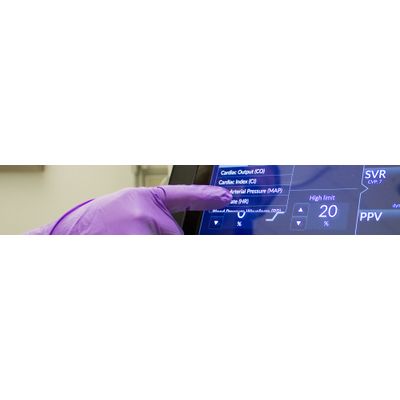

- Home
- Companies
- Retia Medical, LLC
- Applications
- Multi-Beat Analysis Technology (MBA) ...

Multi-Beat Analysis Technology (MBA) for Clinical Impact - Medical / Health Care - Clinical Services
Accurate CO monitoring is essential for effective, proactive hemodynamic management, especially for patients in whom CO is low or changing. An independent study at New York-Presbyterian/Columbia University Medical Center conducted in 40 liver transplant and cardiac surgery patients in the OR or ICU using continuous PA catheter as the reference showed that the Argos Monitor was 50% more accurate than the market leader’s monitor, and that it was 45-50% better in patients with CO < 5 L/min or with changing CO status. [Submitted.]
More accurate than the leading competitor based on esophageal Doppler
The Argos Monitor has also demonstrated high accuracy in a study of 40 high-risk surgeries (27 neurosurgeries and 13 hepatobiliary surgeries) using esophageal Doppler as the reference [Retia Medical data on file].
Publications
- Saugel B, Heeschen J, Hapfelmeier A. et al. Cardiac output estimation using multi-beat analysis of the radial arterial blood pressure waveform: a method comparison study in patients having off-pump coronary artery bypass surgery using intermittent pulmonary artery thermodilution as the reference method. J Clin Monitoring and Computing (2019). https://doi.org/10.1007/s10877-019-00375-zKey finding: The concordance rate for CO changes between PATD-CO and MBA-CO was 89%.
- Greiwe G, Peters V, Hapfelmeier A. et al. Cardiac output estimation by multi-beat analysis of the radial arterial blood pressure waveform versus intermittent pulmonary artery thermodilution: a method comparison study in patients treated in the intensive care unit after off-pump coronary artery bypass surgery. J Clin Monitoring and Computing (2019). https://doi.org/10.1007/s10877-019-00374-0Key finding: CO estimations by multi-beat analysis of the radial arterial blood pressure waveform (Argos Monitor) show 88% agreement compared with CO measured by intermittent PATD.
- Zhang G and Mukkamala R. Continuous and minimally invasive cardiac output monitoring by long time interval analysis of a radial arterial pressure waveform assessment using a large, public intensive care unit patient database. Br J Anaesth, 2012;109(3):339–344.
Key finding: 18.5% calibrated CO error compared to pulmonary artery catheter (single bolus thermodilution) in 184 critically ill patients. - Reisner AT, Xu D, Ryan KL, Convertino VA, Rickards CA and Mukkamala R. Monitoring non-invasive cardiac output and stroke volume during experimental human hypovolaemia and resuscitation. Br J Anaesth, 2011;106(1):23-30.
Key finding: Reliable tracking of CO reductions in 129 healthy humans during central hypovolemia. - Lu Z and Mukkamala R. Continuous cardiac output monitoring in humans by invasive and noninvasive peripheral blood pressure waveform analysis. J Appl Physiol, 2006;101:598-608.
Key finding: 15.1% calibrated CO error compared to Doppler ultrasound in 10 healthy humans during drug and postural interventions. - Mukkamala R, Reisner AT, Hojman HM, Mark RG, Member S, Cohen RJ. Continuous Cardiac Output Monitoring by Peripheral Blood Pressure Waveform Analysis. IEEE Trans Biomed Eng. 2006;53(3):459-467.
Key finding: 12.9% calibrated CO error compared to aortic flow probe in 6 animals during drug and volume interventions.
